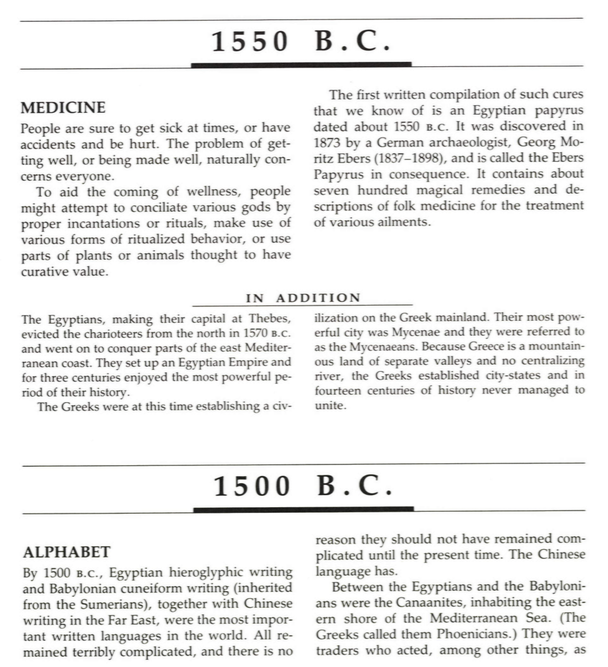Asimov's Chronology of Science and Discovery
Asimov's Chronology of Science and Discovery is a really fun and strange book. I don’t know that I would recommend reading it per se, but it’s a great book to skim. It's been one of my sources for the series I have coming up on very-long-run history, and I thought it'd be fun to read a little about it.
It is a chronological list of scientific advances and other inventions, starting with "bipedality" in 4,000,000 BC and ending with things like "warm superconductivity" in the late 1980s. Asimov (yes, that Asimov), getting his knowledge from I have no idea where (Google didn't exist!), describes each one in simple, direct, matter-of-fact, layperson-friendly language and tries to give a sense of how people thought of it and why it mattered.
It's easiest to give a feel for this book with a sample page:

If you’re patient and abstract-minded enough, the book feels like reading a story. A story that seems like an okay candidate for “most important story ever.”
The other thing I really liked about this book was its implicit conviction that all of these scientific advances can be explained, visualized, and made to basically make sense. After reading it (really, by the time I'd read the first ~50% of it), I felt like I could somehow intuitively, vaguely imagine how we've made most of these advances. I would describe most of them as some combination of:
- Trial and error, dumb luck, happy accidents, like "some rocks in the fire started oozing this weird shiny substance [copper]" and "when I rub amber and touch it I get a shock."
- Dogged curiosity and determination to make sense of different observations ("how can we extract copper from rocks most efficiently? How do we produce those static shocks, can they travel through a wire, how fast do they travel, can we figure out how to store and discharge them at will?")
- Coming up with the most simple, elegant, precise descriptions (often mathematical) that explain all the many observations we've made ("based on all the tests we've run in all the situations we can come up with, electricity seems to behave as though there are invisible 'lines of force'; can we come up with mathematical equations that describe these lines of force and tell us what the effects of an electric current in any given place will be?")
- Relentlessly looking for challenges to the existing theories and building new ones to accommodate them.
This book has made me generally more interested in trying to understand the high-level explanations for how all the magic of the modern world came to be.
There are enough "In addition" sections that you can see what was going on more broadly in the world at the same time.
Weaknesses of this book/reasons not to read it:
- Logistics. It's not available as an e-book or paperback, only as a massive hardcover. Lugging it around will develop your muscles to the point where the only thing more attractive than your muscles is how you look reading that massive book about science. But if you're already in a relationship, pain in the neck. So I signed up for a book-scanning service and shipped them a copy; the service rips the binding out of books, scans them in and sends back a PDF. I then did my best to extract the text from the PDF, and ended up with a Kindle-friendly Word document whose only flaw is that sometimes a sentence will randomly cut off and continue several pages later. For a book like this though, it's still readable (...mostly). I’m just going to go ahead and put the link here and ask that you buy a physical copy of the book (honor system) if you download it. If I get a cease & desist letter or something I will take that link down (but will also take down the link to buy it!)
- There's a lot of stuff the book doesn't explain well at all; you definitely will be left with many questions. (That said, Asimov does explain a lot of things well, and I haven't found another book that can compete with his explaining abilities with this kind of breadth.)
- When we get past 1800, and especially past 1900, there are a lot more choices of what to talk about, and Asimov opts for listing every single new element, everything that won a Nobel Prize, and generally just tons and tons of hard-to-contextualize assorted scientific facts while declining to discuss a lot of important real-world inventions (for example, he doesn't mention the washing machine). By 1960, the book is nearly unreadable; it's mostly esoteric stuff that is very hard to understand and may or may not ever matter.
This book is especially strong for understanding relatively early (pre-1800, maybe pre-1900) history. After that, things get complex enough that I found myself going back through the book and stitching together entries in order to tell cohesive stories of some big developments like the discovery of metallurgy, the development of glass -> spectacles -> microscopes and telescopes, the path to Newton's laws, and the discovery of electormagnetism (culminating in Maxwell's equations, the Newton's laws of electromagnetism). My notes on that are here.
Asimov has written a terrifying number of other nonfiction books - science, history, a guide to Shakespeare, a guide to the Bible. One of his books, Asimov's Guide to Science, appears to be the same exact book as the one discussed here, just in a different order (by topic instead of chronological).